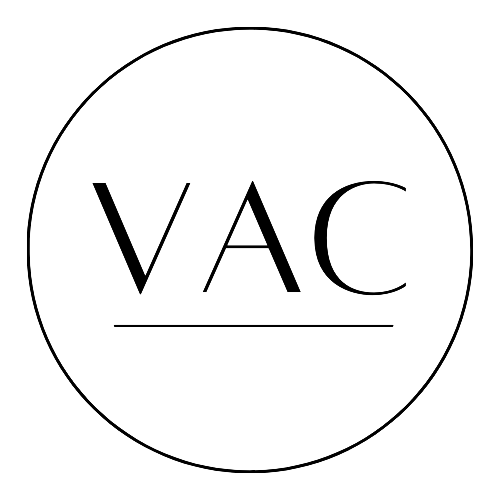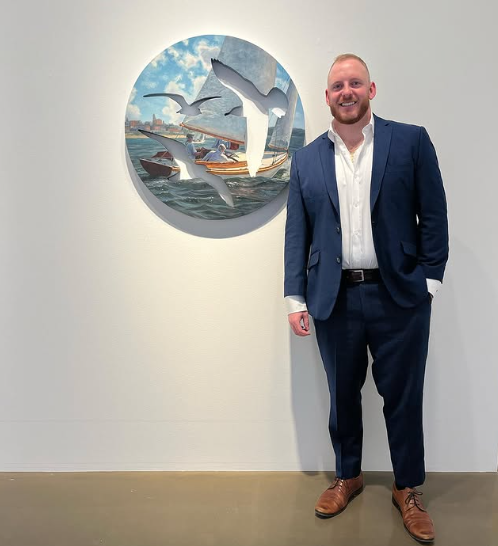Taking Shape: The Evolving Picture Plane of Contemporary Art
By Emma Hapner, July 17, 2025
What happens when a painting refuses to stay within its frame? For centuries, artists have worked within the limits of the picture plane; the flat surface of the canvas has served as a space for illusion, narrative, and visual control. From Renaissance masters who used perspective to create imagined depth to modernists who embraced the canvas as a physical object, the picture plane has been both a site of invention and a structural boundary. Today, however, a growing number of contemporary artists are choosing to push beyond that surface entirely.
By distorting the frame, shaping the canvas, or merging painting with sculpture, artists such as Ryan Davis, Emily Furr, and Almendra Bertoni challenge the conventions of what a painting can be. Their works do more than depict; they extend, bulge, and reach into real space, creating experiences that are as much felt as seen. Through radically reshaped supports and highly personal subject matter, these artists reimagine the relationship between the viewer, the image, and the surface that holds it. In doing so, they transform the picture plane from a window into a threshold.
Almendra Bertoni, I Used To Float, Acrylic on Wooden Panel, 33 x 35 inches, 2024
One artist pushing the boundaries of the picture plane is Ryan Davis. Davis’s paintings navigate the intersection of lived experience and visual storytelling, drawing from a life shaped equally by art and labor. Raised in a coastal town in Massachusetts, Davis grew up immersed in a working-class community defined by the rhythms of the sea. His early exposure to both traditional seascape painting and the physical demands of lobstering forged a sensibility rooted in observation, repetition, and reverence for place. Over time, the duality of being an artist and fisherman has become the engine of his practice.
Known for his oil paintings and charcoal drawings, Davis’s work spans from atmospheric New England seascapes to graphic explorations influenced by Pop Art. His recent paintings, however, mark a bold evolution. These new pieces depart from conventional rectangular formats, instead adopting shaped canvases that echo the visual language of the maritime world, like buoys, hulls, trap doors, portholes. By distorting the frame itself, Davis reframes the familiar: fishermen at work, ocean currents, the tension of weather and tide. The result is a dynamic reinterpretation of the seascape genre—one that emphasizes perspective, labor, and the intimacy of daily rituals on the water. These shaped paintings become portals or windows into moments that are not just seen but felt, where the edges of memory, myth, and lived experience blur.
Another artist who’s work inevitably comes to mind is Emily Furr. Furr’s paintings burst with color, character, and quiet complexity. Based in Charleston, South Carolina, Furr is known for her vibrant oil paintings and immersive installations that blend humor, anxiety, nostalgia, and joy. Her imagery range from chickens to produce stands and feel at once whimsical and pointed; it draws on everyday southern iconography while exploring deeper emotional undercurrents.
A defining element of Furr’s recent practice is her use of shaped canvases, which reimagine the boundaries of painting and invite viewers into a more physical, dynamic relationship with the work. Rather than adhering to the traditional rectangular frame, her canvases twist, bulge, and curve to echo the forms of her subjects or emotions. These formal decisions upend the illusion of the picture plane as a passive surface; they transform it into a sculptural and conceptual space. In doing so, Furr not only plays with form and color but also with the expectations and conventions of painting itself. Furr holds degrees from Winthrop University and the University of North Carolina at Greensboro, and has exhibited widely, including in the celebrated ArtFields competition. Her work lives as comfortably online as it does in physical space; it invites broad access to a practice that is both deeply personal and visually generous. By breaking open the picture plane, Emily Furr makes space for strangeness, humor, and emotion; she redefines what a painting can hold and how it might spill out into the world.
Lastly, Almendra Bertoni also transcends the traditional picture plane. Bertoni is a multi-disciplinary artist from Buenos Aires, Argentina, currently based in Brooklyn, New York. Her practice spans painting and sculpture, guided by a fearless investigation of religious symbolism, sexuality, and emotional vulnerability. Drawing from art historical references and contemporary culture, Bertoni creates surreal compositions that explore the tension between the sacred and the sensual. Central to this exploration is her innovative use of sculptural, shaped panels that extend painting beyond the traditional picture plane.
Rather than treating the canvas as a flat window into an image, Bertoni constructs each work as an object in its own right. Her shaped wooden panels reference architectural forms found in churches like altars, arches, and devotional niches, while also evoking bodily curves and ornamental motifs. These supports are not merely decorative; they activate the edges of the work and give it physical presence. The painting is no longer confined to a rectangle; instead, it moves into space, inviting viewers to experience it more viscerally. By combining ornate surfaces with sculptural structure, Bertoni reimagines painting as both an image and an object. Her works challenge the expectations of how art should be viewed, blurring the line between sacred object and contemporary critique. They reach beyond the confines of tradition, offering an experience that is both visual and spatial; intellectual and bodily; reverent and rebellious. Bertoni’s practice is unapologetically bold. It invites reflection and confrontation; it holds space for discomfort, humor, pleasure, and doubt. Through her shaped panels and rich symbolism, she constructs a world where holiness and humanity coexist—and where the frame is never the limit.
Featured:
Ryan Davis
Website: https://www.ryan-davis-artwork.com/
Emily Furr
IG: @emily_furr
Website: https://www.emilyfurr.com/
Almendra Bertoni
IG: @almendrabertoni
Website: https://www.almendrabertoni.com/
















